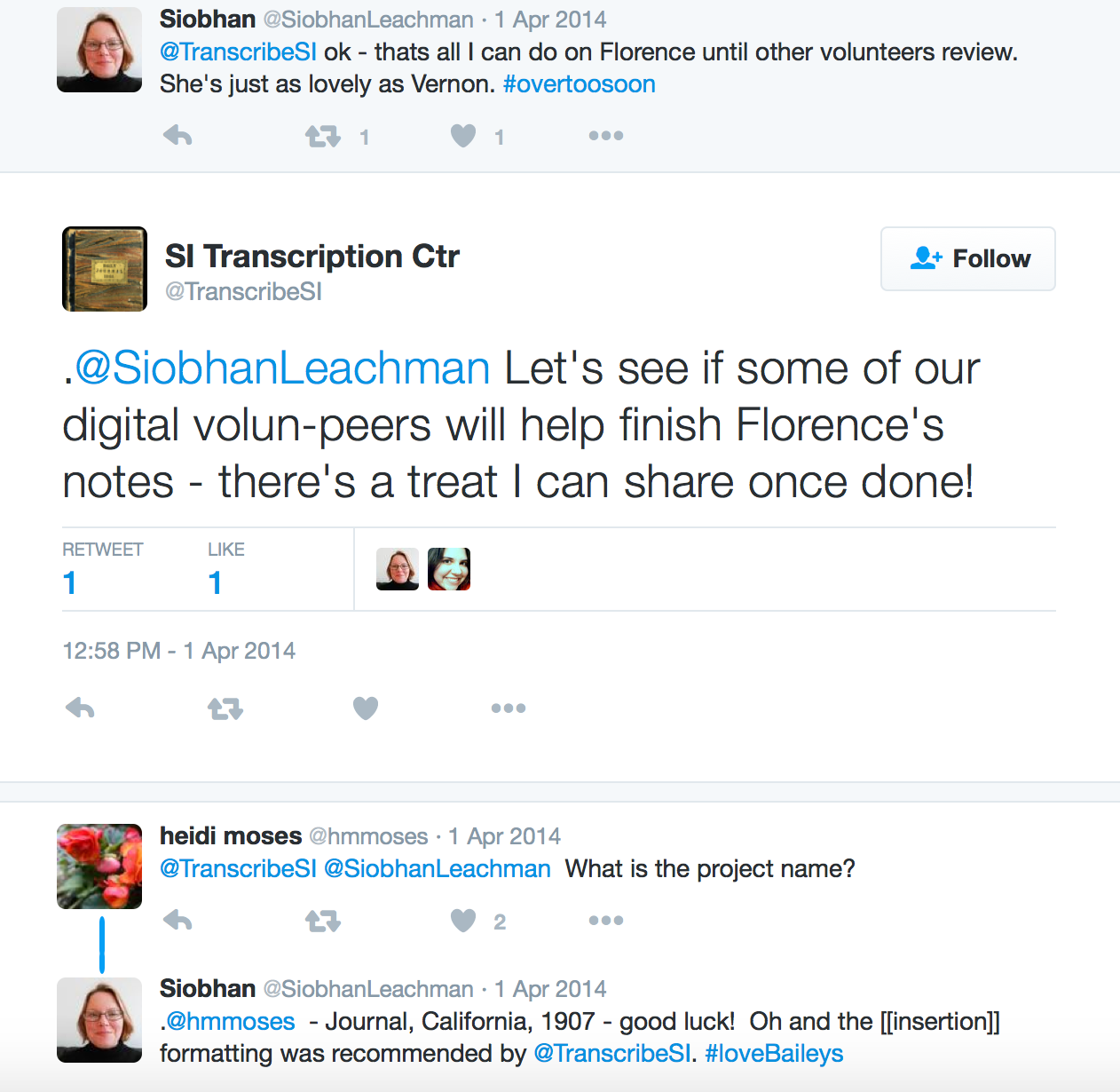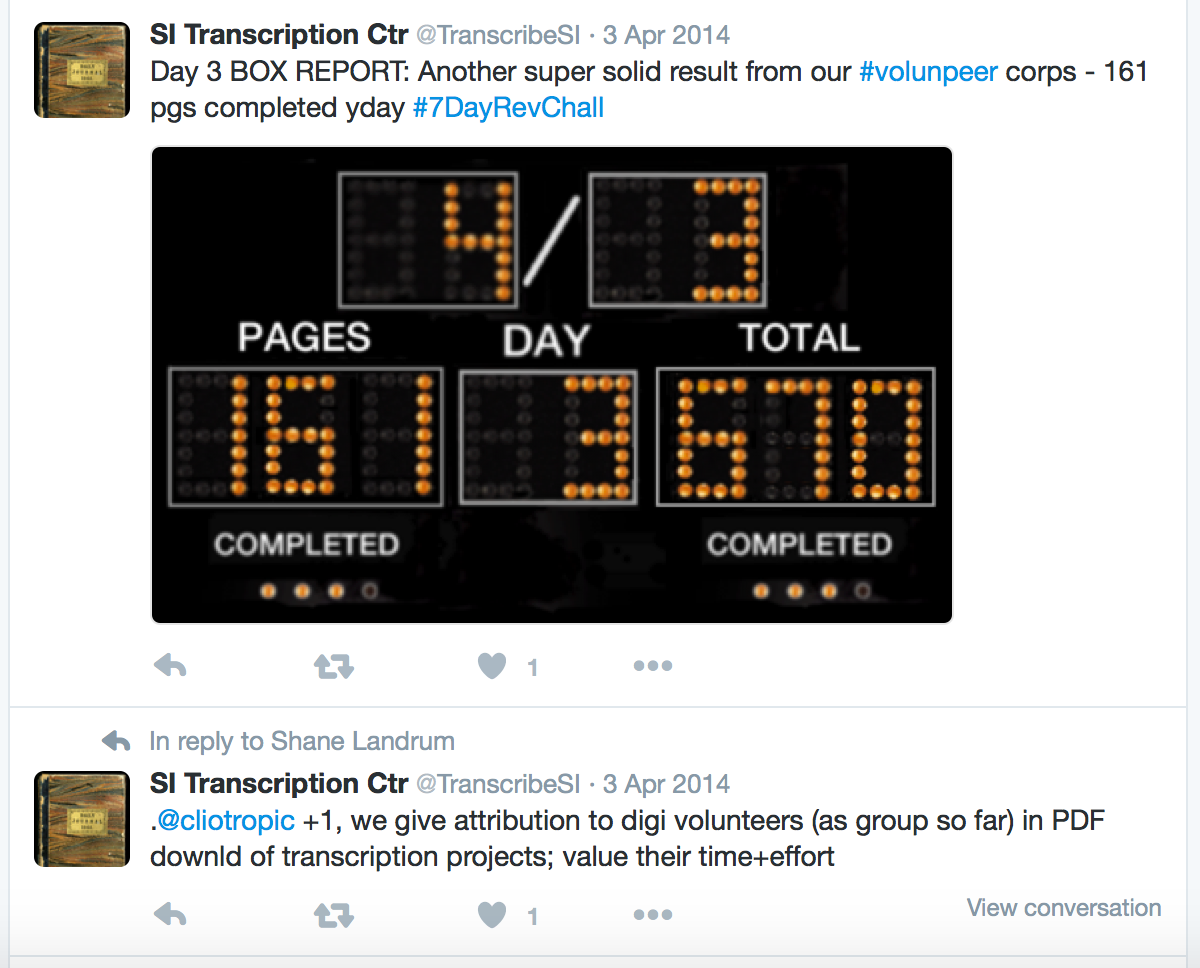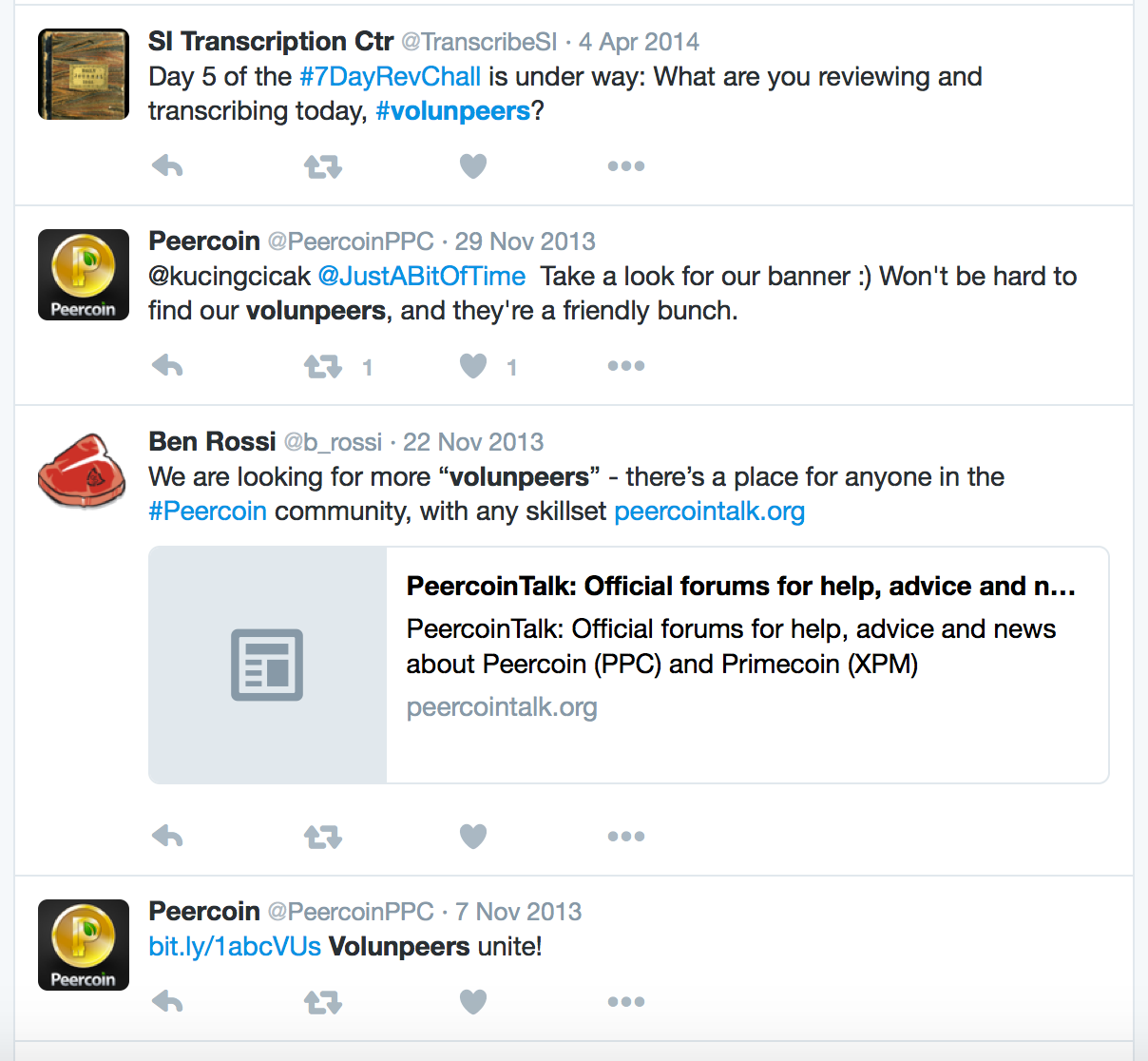Category: Citizen Science
Volunpeers: Hashtag, Identity, & Collaborative Engagement

“Volunpeers” is a flexible term for volunteers, organizations, and institutions to succinctly represent the knowledge-building activities and collaborative enterprise in which they are engaged. When used as a hashtag, #volunpeers can be leveraged to quickly connect individuals to asynchronous collaborative activity. It is a term that may be used to draw novice volunteers into public discussion about crowdsourcing and citizen science activities, as well. It also may be used as a way to announce discoveries and call out for help. “Volunpeers” specifically challenges heirarchical, as well as the exclusivity of, knowledge production and the efforts to created that knowledge; as part of a wider set of activities, it is a term and an identity that may be affiliated with the promise of digital technologies, the internet, and the democratization of knowledge. It is also an identity adopted by participating volunteers to describe themselves and their positioning with this crowdsourcing project of the Smithsonian Transcription Center. This post describes the ways I first implemented the term in coordination with the activities of Smithsonian’s Digital Volunteers and the Smithsonian Transcription Center in April 2014 and its continued use today.
I was several months into my role as project coordinator for the Smithsonian Transcription Center in April 2014, plus a day or two into our second TC 7 Day Review Challenge. I’d issued a goal of reviewing–and ideally completing–as many pages as possible in 7 Days. It was an open, but still formidable task.
Digital volunteers at this point tended to communicate directly with the Transcription Center (i.e. me) via feedback e-mails and tweets. The TC did not and still does not have a discussion board. One drawback of this design decision: some kind of work-around might be necessary when volunteers wanted to bounce ideas or ask others to join them on challenging projects. However, it is also a design decision that creates alternative opportunities for communication between participants – specifically in the social media spaces in which they may already operate.
While responding to a volunteer’s tweets on 01 April 2014 using the @TranscribeSI Twitter handle, I suggested another “volun-peer” might be able to help. In the first 2 days of using these 9 characters, I swiftly incorporated the term “volun-peer”, then “volunpeer”, then the hashtag #volunpeers into the rhetorical approach and central mindset of the TC in three key ways.
In the first use of the hyphenated term, I’m suggesting a portmanteau to blend of meaning of volunteer and peer. This implicitly rejects a hierarchy of volunteers and highlights the peer review and collaboration of the TC.
In the second use, I’m still applying a hyphen but signalling members of the group to an unknown wider set of members while setting out a call-to-action.
In the third use, I continue to use the hyphenated term and this time attempt to catalyze a call to action focused around content: a dapper Leo Baekeland and his diaries.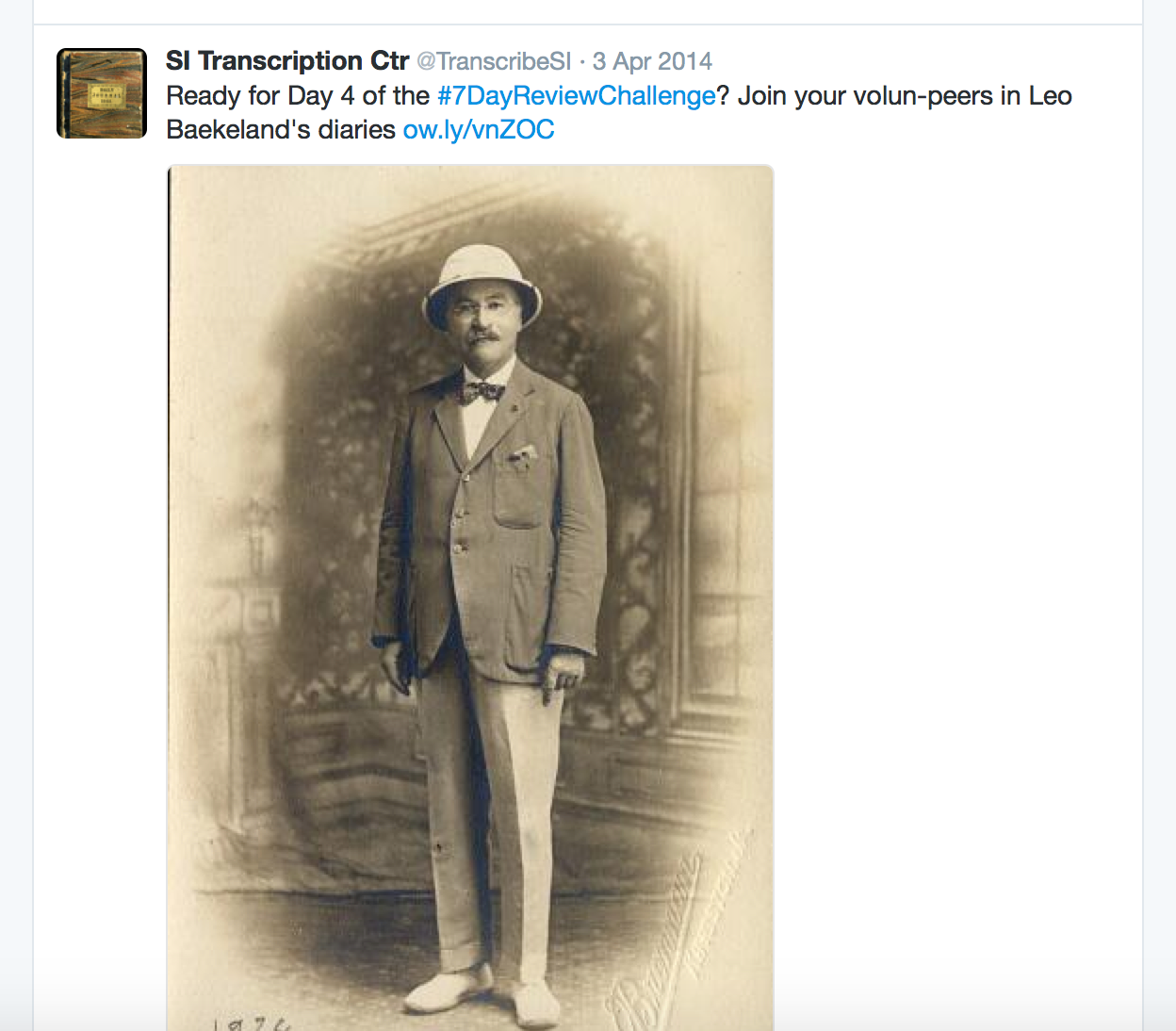
I actually start using a hashtag and non-hyphenated term in the fourth use of volunpeers on 03 April 2014. This first time the hashtag term is singular: #volunpeer. I used it in this way to share the collective contributions of all volunteers engaging with the 7 Day Review Challenge.
Finally, in the 5th use of the term the next day, I use the plural hashtag. In this case, I’m asking questions and trying to generate genuine discussion using this hashtag.
By the 6th, 7th, and 8th uses, the hashtag is allowing me to attach to it messages of encouragement, questions, and report outs. This Grand Total summary below is my 7th use of the term “volunpeers”.
I’m also able by 07 April 2014 to leverage the structural capacity it affords and its discoverability as a hashtag (c.f. Mechant & De Marez, 2012).
In a forthcoming article in a volume of COLLECTIONS: A Journal for Museums and Archives professionals, I describe the ways a hashtag can be a useful string of characters, plus so much more. Specifically, as a hashtag, #volunpeers is employed as a vehicle for conveying information through a social network to the eyes of other willing and interested volunteers.
To summarize myself: the term #volunpeers moves beyond an ascribed label to an adopted identity for those who feel affinity toward its meanings. It also actively incorporates collaborative construction of knowledge. Using #volunpeers chips at barriers and hierarchies of authority between an institution and public through on-going interaction. Staff are learning and improving their workflows through interaction with the public, as well. Rather than telling and directing, #volunpeers can be deployed by the public as well as staff as a means of sharing and inviting productive discussion and inclusion with their work. I use the term to signify the boundaries and the ways they might be blurring, as with collaborative space that uses peer review; and to honor what is possible together rather than what is being done by individuals.
I should note that while @TranscribeSI was the first to use the hashtag #volunpeers, it was used several times in 2013 by a PeerCoin community; and specifically to signal knowledge exchange!
So, what do you make of “volunpeers”? What does it mean to you? Do you think #volunpeers is appropriate, ambitious, or too conservative for crowdsourcing and citizen sceince? Do you consider yourself a volunpeer and if so, why?
Mechant, Peter, and Lieven De Marez. 2012. “Studying Web 2.0 Interactivity: A Research Framework and Two Case Studies.” International Journal of Interactive Communication Systems and Technologies (IJICST) 2, no. 2: 1-18.
Dreamy Digital Engagement at SXSW Interactive
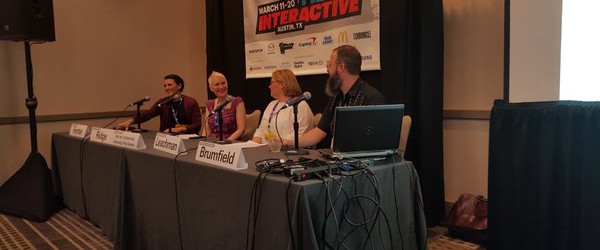
At SXSW Interactive, I was on the trail of engagement, interaction, communication, and online collaboration – from opening sessions to my crowdsourcing panel on 12 March and beyond.
In November 2015, I was frankly pumped to have my panel on building engaged communities through crowdsourced transcription accepted for SXSW Interactive. The panel we submitted included three forward-thinking, complimentary mindsets with unique views into the challenges and complexities of crowdsourcing: digital curator Dr. Mia Ridge and independent software developer Ben Brumfield and long-time Citizen Scientist and self-identified #volunpeer Siobhan Leachman.
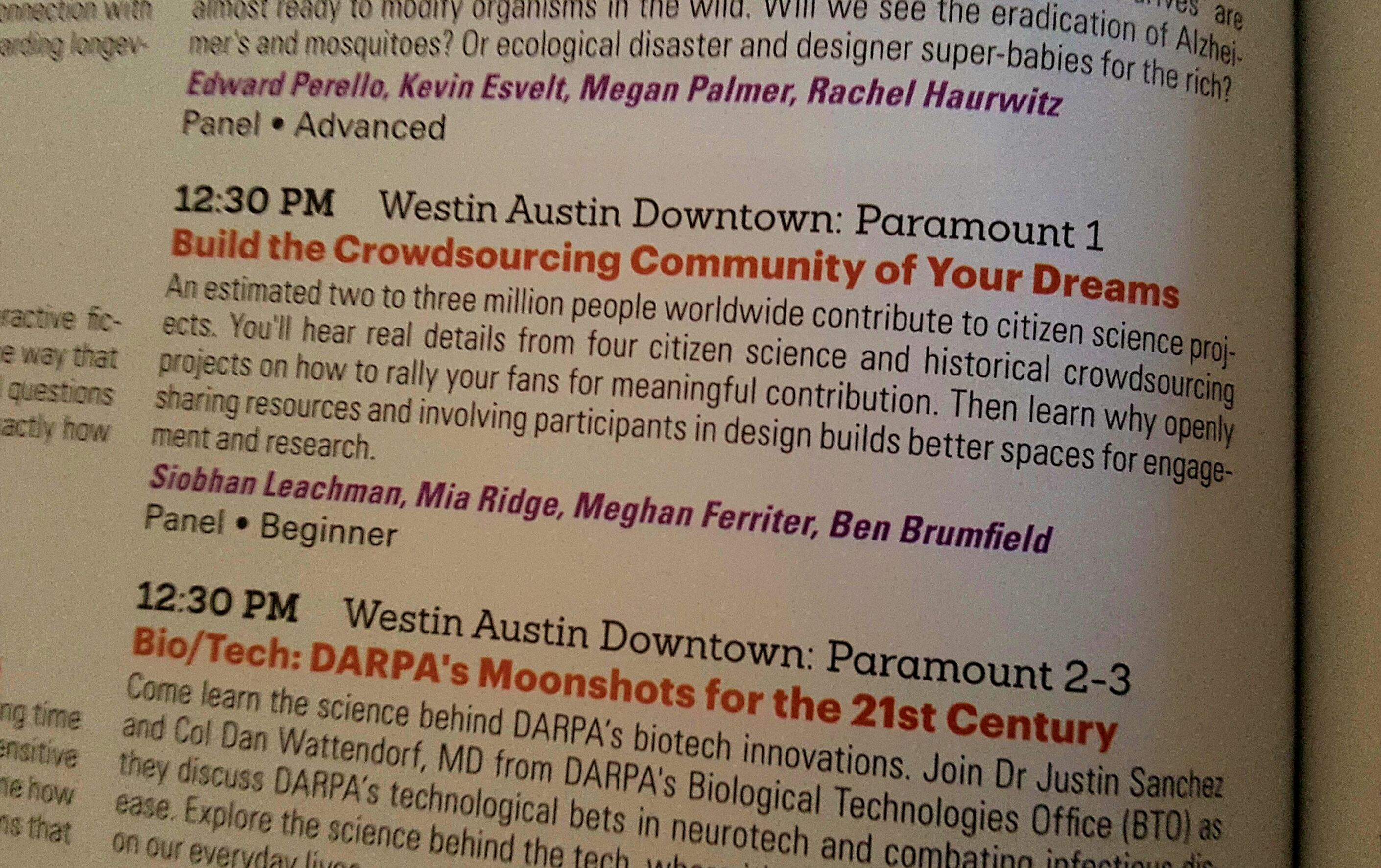 When March 2016 arrived, I was well past thrilled – but also focused on making our panel useful and engaging, even as we discussed approaches for engagement. We arranged our session as a brief introductory round robin, a series of discussion prompts, and open discussion – finalized over pretty delicious brats and brews at Easy Tiger. Mmm, “brain food.” We also gathered useful resources for getting up to speed on our discussion and shared them along with our panel slides.
When March 2016 arrived, I was well past thrilled – but also focused on making our panel useful and engaging, even as we discussed approaches for engagement. We arranged our session as a brief introductory round robin, a series of discussion prompts, and open discussion – finalized over pretty delicious brats and brews at Easy Tiger. Mmm, “brain food.” We also gathered useful resources for getting up to speed on our discussion and shared them along with our panel slides.
On Saturday, March 12, during our standing-room only session, we had observations and direct questions with a practical bent. Specifically we heard questions about tried-and-true tactics for recruiting and retaining participants (lifecycle of participants). We were able to reflect on our approaches, as well as what we might do as best practice. We were also asked about the ways crowdsourcing can be integrated as more of a “win” such as being acknowledged as a credited volunteer contribution. We also were asked what we viewed on the horizon for crowdsourcing. Mia is concerned with machine learning and leveling up human computation, Siobhan is most interested in the connections between the data, while Ben is focused on the mobile writing on the wall. I’m interested in all of those things, but also maintaining supportive spaces + using the data + new tasks such as audio transcription and image-based decision trees (for the TC). Finally we also had queries about the potential to integrate crowdsourcing into the classroom. We offered smaller examples of integration in secondary and primary schools, as well as with regard to life-long learning. Siobhan rounded up the commentary in this storify.
As I wrote elsewhere in our bid for selection: “The most important element of our panel is passion – it will become clear to you if when we’re selected that we aren’t merely advocates for the power of many hands making light work. Rather we want to make those tools, projects, and experiences the very best they can be. We also support openly sharing best practice and the product whenever possible.” It was a pleasure to convene with Siobhan, Ben, and Mia. Check in with Mia’s round up of our panel at SXSW.
Are you thinking about what’s next for crowdsourcing? Join us in Krakow at DH2016 on 12 June to sight the terrain that lies ahead for crowdsourcing. You can apply and learn more about our goals for a collaborative session here.
Watch this space for my round up of the rest of the sessions I attended at SXSW: including but not limited to”posts that disappear,” seeding entrepreneurial cities, misguided understandings of participation barriers.
Featured Image via Mike Killi’s tweet – thanks for spending the session with us, Mike!
Measuring Success with MicroPasts (September 2015)
I’m finalizing an article about the strategies and tactics I use as Project Coordinator for the Smithsonian Transcription Center. I’m specifically reflecting on measuring progress with the TC goal(s) and museum and archive goals. Of course, that immediately calls to mind this presentation I gave (remotely) as part of the MicroPasts September 2015 Workshop.
For Good Measure
Although I was not able to physically attend the workshop held at the UCL Institute of Archaeology on 23 September 2015, I was delighted to be included in the discussions remotely as we move toward more robust participatory and crowdsourcing programs. Sharing factors of success for each type of project and using these details to overcome the challenges we all face in designing, managing, and improving our projects will only serve to lift all ships.
If you’re interested in more context, you can also explore video from the 31 March 2015 MicroPasts Conference at the Royal Geographic Society; here’s the presentation I made about the Transcription Center during that event.
SI-Q: Making history by crowdsourcing & sharing knowledge
How can you help the Smithsonian make history? Just by volunteering and sharing what you know!
The Smithsonian Institution is rooted in the crowdsourcing tradition and there are more than 30 projects actively seeking your input right now (try these!). Also visit the Smithsonian Transcription Center and learn more about the activities and possibilities at the Smithsonian.
Listen in as Effie Kapsalis and I explain the ways the Smithsonian Institution invites information in and shares knowledge back out with the world.

